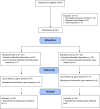The Effect of Using Olive Oil and Fish Oil Prophylactic Dressings on Heel Pressure Injury Development in Critically Ill Patients
- PMID: 32021369
- PMCID: PMC6980853
- DOI: 10.2147/CCID.S237728
The Effect of Using Olive Oil and Fish Oil Prophylactic Dressings on Heel Pressure Injury Development in Critically Ill Patients
Abstract
Introduction and aim: Prevention of pressure injuries in patients hospitalized in intensive care units is significantly important. Therefore, in the present study, the effect of using olive oil and fish oil prophylactic dressings on the development of heel pressure injuries was investigated.
Methods: The present study was a clinical trial conducted in the intensive care unit of Shahid Beheshti Hospital, in Yasuj. Fifty patients, who were at moderate to high risk of pressure injuries development, were randomly divided into two groups based on the mean score of the Braden scale. In one group, patients' heels were dressed using olive oil prophylactic dressing, and in the other group, patients' heels were dressed using fish oil prophylactic dressing. The dressings were changed 3 times a day. Collected data were then analyzed using SPSS v16.
Results: No significant difference was determined in demographic variables among the two groups (p<0.05). In terms of the development of heel pressure injuries, none of the patients in the olive oil and fish oil groups had pressure injuries.
Conclusion: There were no statistically significant differences in either treatment group related to heel pressure injuries outcomes during the 7 days observed in the study. Additionally, both dressings had the same effects. Further studies are recommended in this regard.
Keywords: critical patients; fish oil; nursing care; olive oil; pressure injuries; preventive dressings.
© 2020 Karimi et al.
Conflict of interest statement
The authors report no funding and no conflicts of interest in this work.
References
-
- Zarei E, Madarshahian E, Nikkhah A, Khodakarim S. Incidence of pressure ulcers in intensive care units and direct costs of treatment: evidence from Iran. J Tissue Viability. 2019;28(2):70–74. - PubMed
-
- Galhardo VA, Garroni Magalhaes M, Blanes L, Juliano Y, Masako Ferreira L. Health-related quality of life and depression in older patients with pressure ulcers. Wounds. 2010;22(1):20–26. - PubMed
Publication types
LinkOut - more resources
Full Text Sources


